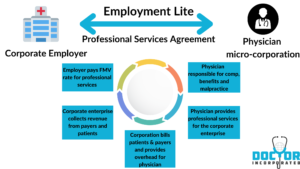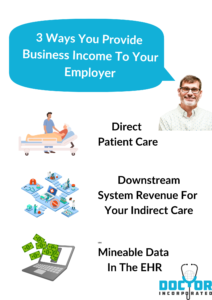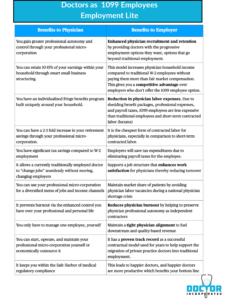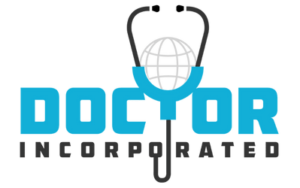[et_pb_section fb_built=”1″ theme_builder_area=”post_content” _builder_version=”4.20.2″ _module_preset=”default”][et_pb_row _builder_version=”4.20.2″ _module_preset=”default” theme_builder_area=”post_content”][et_pb_column _builder_version=”4.20.2″ _module_preset=”default” type=”4_4″ theme_builder_area=”post_content”][et_pb_text _builder_version=”4.20.2″ _module_preset=”default” theme_builder_area=”post_content”]

In recent years, there has been a trend among some large corporations to hire workers as 1099 employees instead of as traditional W-2 employees. This was accelerated by the COVID pandemic.
COVID Changed Things
“Covid has opened our eyes to the fact that there are different ways in which we can work,” said David Noel, a human resources executive at Scotiabank, a Toronto-based bank with 90,000 employees quoted in a recent New York Times article.
Indeed, COVID has given rise to the “1099 employee” for physician labor. In essence, this is a compromise of sorts between doctors who prefer to hold onto their autonomy as independent contractors but who also acknowledge that the job market is now controlled by large corporations who want to employ them.
Over the last generation, doctors moved en mass to traditional employment. The result has been an incredible surge in physician burnout. The parallel trends of physician employment and physician burnout since the 1990s make it difficult to ignore the patterns as coincidental. As an insider, I know this is truly a cause-and-effect relationship. Although burnout has multiple sources, the fundamental problem is that doctors can’t thrive when their professional autonomy is eroded by corporate control and micro-management.
The systemic solution to burnout involves restoring and preserving the professional autonomy of doctors.
This needed systemic correction of restoring physician autonomy shifts in the right direction most naturally when physicians engage with large corporations as 1099 workers (independent contractors) rather than as highly controlled W-2 workers (traditional employment).
Three Post-COVID Trends
The COVID pandemic led to several physician labor trends which have ultimately acted as catalysts to shift the proportion of W-2 and 1099 workers to a growing number of 1099 workers.
The first COVID-related trend is that physician burnout worsened under the ratcheted-down control of corporations who were reacting to the economic & labor threats of the pandemic. The ripples of this are still being felt within physician labor as employers try to ruthlessly eliminate more expensive physician labor and also re-shuffle physician compensation models as cost-cutting measures. Collectively this all adds up to corporations looking for ways to reduce physician labor expenses, while physicians are looking for creative alternatives to relieve the burdens of employment. The most common response includes options that range from reducing your FTE% to changing jobs in search of something better to leaving the system altogether.
Secondly, due to COVID, the light bulb went off for doctors as they discovered that their professional services can often be performed virtually. This has led to the acceleration of telehealth services and the proliferation of telehealth jobs that are all highly suitable for independent contractors rather than traditional employees.
Lastly, doctors observed thousands of both young and old people die from the pandemic. This led to the self-awareness that they need to protect their own well-being. Many began to realize that they couldn’t depend on large corporations to make sure they were balanced and thriving in life. In fact, as mentioned previously many doctors discovered their employers were not so benevolent as their jobs became sources of moral, emotional, or even physical injury.
Self-care and mindfulness about the burdens of employment gave rise to the movement towards part-time positions, side jobs that give you more control of your life, and locums work that allowed for more time off work. Each of these tone down work responsibilities and allow your time to be filled with non-work passions. Gaining control of the work-life balance ultimately is much easier to do as an independent contractor than it is as an employee.
Rather than reduce the amount of time one is working, some have used this as the launching point to leave the system altogether and start-up direct patient care models that place you back in complete control of your professional life while also re-establishing an old-style relationship with patients. COVID helped both physicians and patients alike see that they could be in control of their healthcare
Need For Alternative Employment Options
Each of these trends has resulted in physicians and corporations realizing that there is a need for alternative physician labor and job spaces beyond the full-time traditionally employed doctor. Thus physicians acting as independent contractors, self-employed owners of micro-corporations and various other individualized business arrangements have grown. In turn, large corporate employers have had to adapt to these trends in physician job preferences and create space for the “1099 employee”.
This adaptation to the menu of physician labor options does provide large corporations with some advantages over traditional employment and those include the following.
Advantages to Corporations
-
Cost Savings: Hiring 1099 employees can be cheaper for a corporation since they do not have to pay for benefits, payroll taxes, and other costs associated with traditional employees.
-
Flexibility: 1099 employees offer corporations greater flexibility in hiring and firing. These employees can be hired for specific projects or tasks and can be let go once the project is completed. Their contracts can also auto-renew if the job is long-term, or semi-permanent for the worker.
-
Reduced Liability: Hiring 1099 employees can also reduce the corporation’s liability since these workers are considered independent contractors and are responsible for their own taxes and insurance.
So with these advantages, the “1099 Employee” has come on the scene as a labor category for large corporations who control the physician job market in the US.
But the benefits are not just for the employer, they are also for the worker.
Advantages To The Worker
The 1099 worker trend has been largely driven by its flexibility, allowing you to work when and where you want, with no employer commitments.
There are several advantages for physicians to choose to be 1099 employees, including:
-
Greater flexibility: As a 1099 employee, you have more control over your work schedule and don’t have to participate in all of the extra time commitments associated with corporate citizenship. You can also choose to build your business-to-business relationships around combinations of part-time and side work that are more congruent with your preferred home-work balance.
-
More tax deductions: Independent contractors can deduct many expenses that employees cannot, such as home office expenses, equipment purchases, travel expenses, CME, auto expenses, and other fringe benefit programs that allow you as a professional to retain more of your high income. In fact compared to W-2 physicians, with wise micro-business structuring you have the potential to retain 10-15% of your high-income earnings. Ultimately, working smarter rather than harder is a better way to add this income to your household in comparison to earning more.
-
Higher earnings potential: Independent contractors often earn more money than employees since they can negotiate their own rates and work with multiple clients simultaneously. Having said this, if you engage in a long-term contracting relationship through a structure like employment lite, your compensation matrix/formula will likely mirror your W-2 peers.
-
Individualized benefits: While not having access to benefits such as health insurance and retirement plans may seem like a disadvantage, it can also mean more flexibility and autonomy for you. Additionally, independent contractors can often deduct the cost of their own benefits from their taxes. This can be huge for physicians, especially with larger retirement options such as a cash balance plan.
-
Opportunity- Independent contractors are often hired for specific projects, which can provide opportunities to learn new skills and gain valuable experience. Whether you talking about your primary job or your side job(s), you have the opportunity to explore your professional preferences and expand your professional skills at different jobs. Diversity is the spice of life.
Overall, being a 1099 employee offers greater freedom, flexibility, and earning potential, but it also comes with greater responsibility for managing your own taxes and benefits.
So “1099 employees” have popped up as the modern workplace has evolved and the advantages of long-term independent contracting have become clearer to both physician workers and corporations.
What is 1099?
Just to briefly review, a 1099 form is for reporting non-employee pay to the IRS and is different than form W-2 which is used to report income paid to employees. A 1099-NEC form is used to report amounts paid to non-employees, like independent contractors and other businesses to whom payments are made.
If you get 1099 from your employer, that’s a sign that your employer sees you as an independent contractor rather than an employee. Workplaces aren’t the only entities that may send you 1099, though.
What Does a “1099 Employee” Mean?
The modern term “1099 employee” is essentially an oxymoron because 1099 income is by definition non-employee compensation. Thus from a tax code & labor law standpoint, it’s not possible to be an employed person who receives their income as 1099.
But the fact is that are thousands, if not millions of workers in the US who would consider themselves “1099 employees”. This includes me via an employment lite contract which I have extensively written about on this blog as a better model than traditional employment for physicians.

So how did the physician as a“1099 Employee” concept and terminology come onto the scene?
The 1099 Employee Physician
With all of the trends added together, physician employers are beginning to frame all physician labor as non-permanent—which is why they include 90-day no-cause termination clauses in your contract. This non-permanent worker designation places both you and the large corporation that employs you in the position to distribute your compensation as 1099 income, rather than W-2 income.
You should closely observe this developing new space for physician workers because it provides you with a better foundation for preserving your professional autonomy over traditional employment.
But you also need to be aware that employers are reluctant to give up the space of traditional employment for doctors. For them, it is all about control. Honestly, they are reluctant to give up their control of your professional services as a worker. That is what they pay for when they gave you that employment contract filled with financial enticements. They don’t really care much about you personally, but they do want to control all of the business that flows through your professional work. Unlike their regular employees, they fear contracting work will lead to a leakage of your time, energy, and business revenue to other business options. In comparison by calling you an employee, and shackling you with non-compete and restrictive covenant clauses in your contract, they are able to nearly completely control you and your professional work.
Thus, although classifying you as a contractor offers them numerous advantages they are still concerned this classification could lead to a loss of their financial gains in comparison to employing you. You a revenue-producing machine for them, and they want to harness all of your energy for their benefit.
They aren’t concerned about this with other gig workers or contractors because they don’t create business revenue like you. You are special and unlike any other workers in their employment web. You are a unique business engine for these corporations and as you drive revenue through their enterprise not only with patient encounters but in three separate channels as noted below:

1099 = Loss of Control For Employers
The phrase “1099 employee” generally describes a person who is self-employed person and independent. The independence component for doctors is what employers want to avoid because it means that you can have business-to-business relationships with others, and they don’t want to see that happen—especially to their competition.
But that independence is the critical foundation to your well-being as a doctor because it helps preserve your professional autonomy. This is one of the most ways that you can prevent burnout from occurring in your life.
Now is the time for you to seize this moment in time when the two worker classifications of employment and independent contractors have given way to the addition of the third space of the “1099 employee” for physician labor.
The 1099 Physician Employee
The long-term independent contracting classification is a newer physician job space where you can legitimately be called a “1099 Employee” for large corporations.
It is a reflection of what both parties need in today’s economy.
Doctors need autonomy and control over their personal and professional lives and corporate employers need both short-term and long-term physician labor who can reliably fill their service line needs in a heavily aligned manner.
Traditional employment is still a foundational component for physician labor but progressive options like “1099 employment” is a needed addition to the labor space because it still allows both parties to flourish.
The Better Physician Employment Model
1099 employees are independent contractors who are not employed by a single company but instead provide services to multiple clients or companies. You as a physician are one of the most common types of 1099 employees. This structure is becoming increasingly popular for our tribe because it allows you to have more control over their work schedule. This flexibility makes it easier for you to pursue your passions both inside and outside of medicine.
Some of you may find it stranger to call yourself a contractor—because it’s easier to generically call yourself an “employee” due to the longer length of time you plan to work at a job, your alignment to the corporation, or your loyalty to their business brand. That was the route that I took in my personal transition from employment to employment lite 10 years ago. In part that was because I transitioned from employee to contractor with the same company, while doing the same job in the same location. Thus, it was just easier for me externally appear to others as the same employee I had always been, while internally knowing that my business structure and cash flow with my 1099 income was much different than my W-2 income.
Benefits Both Doctor & Employer
The 1099 employment structure is beneficial to both the doctor and the employer especially when it is configured through an employment lite agreement. Take a look at this list describes how this truly is a win-win job structure for both sides.

For high-income earners like you, choosing to be 1099 employees especially leads to tax advantages that far supersede the W-2 physician.
For this reason alone, more and more doctors are choosing to become 1099 employees instead of traditional W2 employees.
I will take a closer look at the taxes in my next blog post.

[/et_pb_text][/et_pb_column][/et_pb_row][/et_pb_section]


